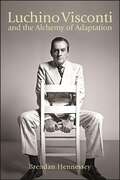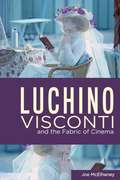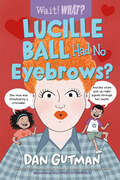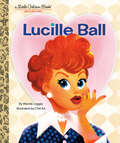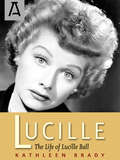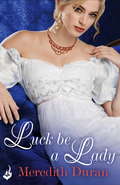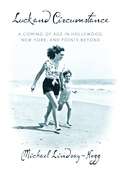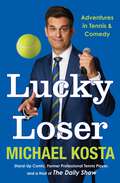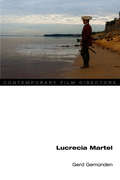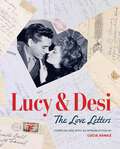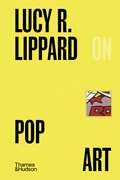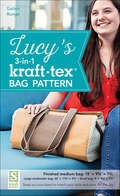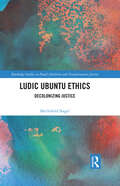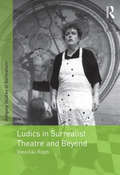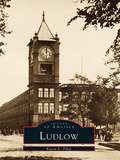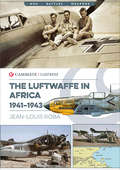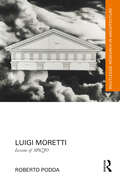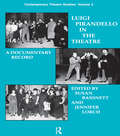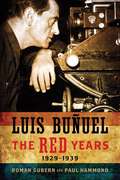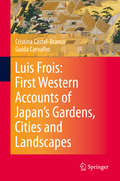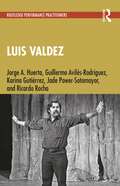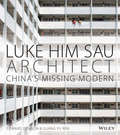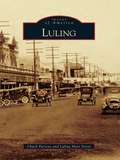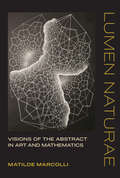- Table View
- List View
Lucas Wars: The True Story of George Lucas and the Creation of Star Wars
by Renaud Roche Laurent HopmanRebellious child who cheated death. Indomitable visionary. And mastermind behind one of the world's most enduring fandoms: Star Wars."An epic tale of creative struggles and triumph." —Jeffrey Brown, bestselling author of Darth Vader and SonIn a tale befitting the saga he created, Lucas Wars follows George Lucas’s journey from aimless dreamer to filmmaking trailblazer and prodigy of the New Hollywood movement. While his fellow rising stars—directors like Francis Ford Coppola, Steven Spielberg, and Martin Scorsese—craft The Godfather, Jaws, and Taxi Driver, Lucas follows his childhood dreams and begins work on an epic fantasy . . . which, he soon discovers, is not without its epic challenges.Writer Laurent Hopman and artist Renaud Roche dive deep into the creative process behind Star Wars: A New Hope, from the hell of casting to the nightmare of filming. Lucas is forced to juggle actor quarrels, a secret love affair, costume and set mishaps, and constant pushback from film execs. But despite it all, a landmark movie emerges—one that changes the medium of film forever. Lucas Wars is an exhilarating underdog story and a unique glimpse into the world of cinema. But most of all, it’s an ode to the magic of childhood and the value of perseverance.
Luchino Visconti and the Alchemy of Adaptation (SUNY series, Horizons of Cinema)
by Brendan HennesseySince the beginning, much of Italian cinema has been sustained by transforming literature into moving images. This tradition of literary adaptation continues today, challenging artistic form and practice by pressuring the boundaries that traditionally separate film from its sister arts. In the twentieth century, director Luchino Visconti is a keystone figure in Italy's evolving art of adaptation. From the tumultuous years of Fascism and postwar Neorealism, through the blockbuster decade of the 1960s, into the arthouse masterpieces of the 1970s, Visconti's adaptations marked a distinct pathway of the Italian cinematic imagination. Luchino Visconti and the Alchemy of Adaptation examines these films together with their literary antecedents. Moving past strict book-to-film comparisons, it ponders how literary texts encounter and interact with a history of cultural and cinematic forms, genres, and traditions. Matching the major critical concerns of the postwar period (realism, political filmmaking, cinematic modernism) with more recent notions of adaptation and intermediality, this book reviews how one of Italy's greatest directors mined literary ore for cinematic inspiration.
Luchino Visconti and the Fabric of Cinema (Queer Screens)
by Joe McElhaneyIn Luchino Visconti and the Fabric of Cinema, Joe McElhaney situates Visconti’s films as privileged and deeply expressive instances of a trope that McElhaney identifies as the "cinema of fabric": a reoccurrence in film in which textiles—clothing, curtains, tablecloths, bedsheets—determine the filming process. An Italian neorealist, Visconti emerges out of a movement immediately following WWII wherein fabric assumes crucial functions, yet Visconti’s use of fabric surpasses his colleagues in many ways, including its fluid, multifaceted articulations of space and time. Visconti’s homosexuality is central to this theory in that it assumes metaphoric potential in addressing "forbidden" sexual desires that are made visible in the films. Visconti’s cinema of fabric gives voice to desires not simply for human bodies draped in fabric but also for entire environments, a world of the senses in which fabric becomes a crucial method for giving form to such desires. McElhaney examines Visconti’s neorealist origins in Ossessione, La terra trema, and Rocco and His Brothers, particularly through fabric’s function within literary realism and naturalism. Neorealist revisionism through the extravagant drapings of the diva film is examined in Bellissima and Senso whereas White Nights and The Stranger are examined for the theatricalizing through fabric of their literary sources. Visconti’s interest in German culture vis-à-vis The Damned, Death in Venice, and Ludwig, is articulated through a complex intertwining of fabric, aesthetics, politics, and transgressive sexual desire. Finally, Visconti’s final two films, Conversation Piece and The Innocent, assess through fabric both the origins of Italian fascism and the political tensions contemporaneous with the films’ productions. Fabric in Visconti is often tied to the aesthetic impulse itself in a world of visionaries attempting to dominate their surrounding environments and where a single piece of fabric may come to represent the raw material for creation. This book will tantalize any reader with a keen eye and strong interest in film and queer studies.
Lucille Ball Had No Eyebrows? (Wait! What? #0)
by Dan GutmanFrom the best-selling author of My Weird School: a new entry in the cheerful and engaging biography series centered on high-interest historic figures. Did you know that Lucille Ball could pick up radio signals through her teeth? Or that her career was almost destroyed because she was a registered Communist? Bet you didn’t know that, as a studio executive, she green-lit both Star Trek and Mission: Impossible! Siblings Paige and Turner have collected some of the most unusual and surprising facts about the beloved actress, from her impoverished childhood and her first forays into the film industry to her marriage with Desi Arnaz and her rise to become both the most prominent actress in television and one of its most successful executives. Narrated by the two spirited siblings and animated by Allison Steinfeld’s upbeat illustrations, Wait! What? Lucille Ball Had No Eyebrows? is an authoritative, accessible, and one-of-a-kind biography infused with Dan Gutman’s signature zany sense of humor.
Lucille Ball: A Little Golden Book Biography (Little Golden Book)
by Wendy LoggiaHelp your little one dream big with a Little Golden Book biography about Lucille Ball--and find out why everyone loves Lucy! It's the perfect introduction to nonfiction for preschoolers.This Little Golden Book about Lucille Ball--television star, comedian, producer, and the first woman to own a major studio--is a celebration of a true trailblazer! It's a great read-aloud for young children, as well as their parents and grandparents who grew up watching and loving I Love Lucy.Look for Little Golden Book biographies about these other inspiring people:Dwayne JohnsonQueen Elizabeth II Barack ObamaSonia Sotomayor Dr. FauciJoe BidenDolly PartonKamala HarrisMisty CopelandBetty WhiteFrida KahloRuth Bader GinsburgJackie RobinsonMartin Luther King Jr.
Lucille: The Life of Lucille Ball
by Kathleen BradyEveryone loved Lucy, the scheming, madcap redhead who ruled television for more than twenty years. In life, however, Lucille Ball presented a far more complex and contradictory personality than was ever embodied by the television Lucy. In Lucille: The Life of Lucille Ball Kathleen Brady presents the actress as a fully rounded human being, often at odds with the image she presented as an entertainment icon. Brady has gone far beyond the typical celebrity biography to present a funny, unflinching and ultimately moving portrait of Lucille Ball as a performing artist, daughter, mother, friend, colleague, and television mogul. Many think they know the story of Lucille Ball's life, but Brady provides new details and a fresh perspective on this complex woman through a wealth of anecdotes and firsthand accounts. Lucille Ball is revealed not only as a television archetype and influential icon of postwar American culture, but as a driven yet fragile human being who spent her life struggling to create of life of normalcy, but ultimately failed--even as she succeeded in bringing laughter of millions of fans. In researching Lucille, Brady interviewed more than 150 people from her hometown to Hollywood. She spoke with her grade school classmates, and those like Katherine Hepburn and Ginger Rodgers who met her when she arrived in Hollywood in the 1930s. She gained insights from those who knew her before her fame and from those she loved throughout her life. Film, radio and television history come to life with the appearances on these pages of such greats as The Marx Brothers, Buster Keaton, Louis B. Mayer, and of course Desi Arnaz, who march and pratfall through the pages of this outstanding biography.
Luck Be A Lady: Rules for the Reckless 4 (Rules for the Reckless #5)
by Meredith DuranMeredith Duran returns with another witty, humorous and smart romance in the fourth book of her Rules for the Reckless series. Fans of Julia Quinn, Jane Feather and Eloisa James will delight in Meredith's trademark headstrong heroine, cunning hero and tale of deep emotional intensity!Enter Eveleigh's Auction Rooms at your own risk. Prepare to part with your fortune...and lose your heart.They call her the Ice Queen. Catherine Everleigh is London's loveliest heiress, but a bitter lesson in heartbreak has taught her to keep to herself. All she desires is her birthright - the auction house that was mercilessly stolen from her. To win this war, she'll need a powerful ally. Who better than infamous crime lord Nicholas O'Shea? A marriage of convenience will serve them both.Having conquered the city's underworld, Nick seeks a new challenge. Marrying Catherine will give him the guise of legitimacy and access to her elite world - no one need know he's coveted her for a year now. Their arrangement is strictly business, free from the weakness of love. Seduction, however, is an altogether different matter - an enticing game that he's determined she'll play, and what's more, enjoy... Want more Rules for the Reckless? Don't miss Your Wicked Heart or Fool Me Twice.
Luck and Circumstance: A Coming of Age in Hollywood, New York, and Points Beyond
by Michael Lindsay-HoggFrom acclaimed director Michael Lindsay-Hogg (The Normal Heart, The Beatles' Let It Be, Brideshead Revisited, The Rolling Stones Rock and Roll Circus, etc.), son of glamorous Warner's movie star Geraldine Fitzgerald: a magical dreamscape memoir of his boyhood, coming-of-age, and making his way in the worlds of theater, film, and television. Lindsay-Hogg's father, an English baronet from a family whose money came from the China trade, lived in Ireland and was rarely seen by his son. The author's stepfather was the scion of the Isidor Straus fortune, co-owner of R. H. Macy's; Straus went down with the Titanic, and the author's stepfather was, alas, fortune-less. The author's mother, Geraldine Fitzgerald, the redheaded Irish seductress who won instant acclaim as Bette Davis's best friend in Dark Victory and in William Wyler's Wuthering Heights, spent time with Hollywood's elite--Laurence Olivier, Charles Chaplin, and Orson Welles, with whom she worked in New York at the Mercury Theater and in other productions. Lindsay-Hogg writes of how he wented his way into this exotic, mysterious, and seductive world, encountering as a small boy the likes of Marion Davies and William Randolph Hearst, playing hide-and-seek with Olivia de Havilland, serving drinks to Humphrey Bogart, discussing life with Henry Miller. At the book's center, an offhand comment made to Lindsay-Hogg by his mother, when he was sixteen, about talk circulating (false, she claimed) that she had had a romantic relationship with Orson Welles (Fitzgerald and Welles had lived together at his home in Beverly Hills) and that Welles, rumor had it, was Michael's father ("It's not true," she said. "You know how people put two and two together and get three . . ."). That was the end of the conversation. ("It's time for bed . . . You have school in the morning . . ." she said.) For Lindsay-Hogg, it opened up a whole new realm of his life. He was forever changed by the knowing--of not knowing. Interwoven throughout his narrative is the element of questioning who his father was. Was he the patron saint of American pictures, the legendary genius of the twentieth century, Orson Welles, a consistently inconsistent person in Michael's life . . . or was he the man who considered himself Michael's real father? What did his "father" know? What did Welles know? And what did his mother know to be true (she had brought the author up to believe that she always told the truth)? And when would she tell her son what the truth was . . . As Lindsay-Hogg struggled to make sense of it all, questions of missed chances, conversations never had, questions of what is withheld and what is true took root, dogging him, shaping his life . . . questions still, that haunt and inform this moving, deft, and illuminating memoir.From the Hardcover edition.
Lucky Loser: Adventures in Tennis and Comedy
by Michael KostaFrom a host of The Daily Show and stand-up comic, Michael Kosta, comes a wildly funny and insightful memoir about his unlikely journey from professional tennis player (#864 in the world) to professional comedian (there’s no ranking system in comedy but he’s probably . . . top 50?). Before Michael Kosta was performing stand-up comedy specials and hosting The Daily Show, he was a professional tennis “star,” reaching the lofty heights of the #864 ranked men’s singles player in the world. Stop laughing. That’s better than your world ranking. As a tennis pro, Kosta traveled across the globe, competing in such exotic locales as the Netherlands, Tokyo, and even rural Illinois before deciding to put down his racket and pursue a more stable and predictable career: comedy.In a completely unexpected and wild journey through the backwaters of professional tennis, Kosta shows the unlikely ways life on the court prepared him for life in front of a microphone. Like comedy, tennis is brutally competitive, and most people lose at it. Unlike comedy, no one in tennis puts a gun on the table as they count out your earnings in twenty-dollar bills at the end of the night.And then there are the things that have more to do with what happens to you—and what you end up learning—as part of growing up. Topics include: how to properly discard an unwanted European hard-boiled egg, giving CPR to your dead grandpa, cringe-worthy “sex” in the Red Light District, crying so hard in a car that strangers call the cops, and also happy things like what it feels like when your dreams come true. From misadventures in tennis to the humbling setbacks of comedy, Lucky Loser is a heart-filled story of making your own luck, the universal experience of failure, and the many ways in which we all inevitably lose on the way to success.Lucky Loser includes a 16-page photo insert.
Lucrecia Martel (Contemporary Film Directors)
by Gerd GemündenFilms like Zama and The Headless Woman have made Lucrecia Martel a fixture on festival marquees and critic's best lists. Though often allied with mainstream figures and genre frameworks, Martel works within art cinema, and since her 2001 debut The Swamp she has become one of international film's most acclaimed auteurs.Gerd Gemünden offers a career-spanning analysis of a filmmaker dedicated to revealing the ephemeral, fortuitous, and endless variety of human experience. Martel's focus on sound, touch, taste, and smell challenge film's usual emphasis on what a viewer sees. By merging of these and other experimental techniques with heightened realism, she invites audiences into film narratives at once unresolved, truncated, and elliptical. Gemünden aligns Martel's filmmaking methods with the work of other international directors who criticize—and pointedly circumvent—the high-velocity speeds of today's cinematic storytelling. He also explores how Martel's radical political critique forces viewers to rethink entitlement, race, class, and exploitation of indigenous peoples within Argentinian society and beyond.
Lucy & Desi: The Love Letters
by Lucie ArnazA treasure trove of previously unseen love letters between Lucille Ball and Desi Arnaz, spanning their courtship through I Love Lucy fame and beyond, tells the couple&’s real-life love story in their own words, alongside rare photos from the family scrapbooks. After Lucille Ball&’s death in 1989, dozens of private letters between Lucy and Desi Arnaz were discovered. Now, for the first time, daughter Lucie Arnaz shares the complete collection in this remarkable volume that reveals the romance of one of the most famous couples in history more intimately than anything that has ever been written about them. At turns the letters disclose longing, ambition, jealousy, humor, and, above all, a passionate love affair that has claimed the world&’s interest for more than half a century. This extraordinary collection takes readers back to America during World War II, to the lives of a young couple in the early years of their relationship, with budding careers in Hollywood that were still far from their heyday as the nation&’s top stars. Each letter contains a bit of history as they talk about where they are, what they are doing, and what is going on in the world around them—whether it be a wardrobe fitting with a celebrated designer, remembering the last sensuous night they spent together, or trying to buy just the right refrigerator to please your mother-in-law during wartime rationing. Lucille Ball and Desi Arnaz weremarried from 1940 to 1960, and while the bulk of the letters were written in the early 1940s, the compendium reflects their entire relationship, from an early courtship, through long periods of separation due to work and world events, to a bittersweet end after nearly two decades. This stunning book takes readers as close as possible to the actual letters by featuring reproductions complete with envelopes, stamps, postmarks, and Lucy and Desi's own custom stationery. Further illustrated by rare photos from the Arnaz family scrapbooks, this volume is a revelatory look at a complicated and captivating love story that will amaze even longtime fans who think they have seen it all.
Lucy R. Lippard on Pop Art (Pocket Perspectives #0)
by Lucy LippardExplore the dynamic world of 1960s pop art through Lucy Lippard's insightful analysis of this groundbreaking international art movement. Surprising, questioning, challenging, enriching: the Pocket Perspectives series presents timeless works by writers and thinkers who have shaped the conversation across the arts, visual culture, and history. Celebrating the undiminished vitality of their ideas today, these covetable and collectable little books embody the best of Thames & Hudson.
Lucy's 3-in-1 kraft-tex Bag Pattern
by Gailen Runge1 pattern, 3 sizes, unlimited possibilities This versatile and stylish bag comes in three sizes: small, medium, and large weekender—perfect for those overnight trips (fits carry-on luggage requirements)! Play with 2 different colors of kraft-tex and customize the interchangeable band with outside zipper pockets, inside passport pockets, and even knitting needle holders! Or add elastic straps and use the band by itself to carry your yoga mat or picnic blanket. The clever zipper treatment allows each of the three bags to open wide, making finding your necessities a breeze. Includes advice and tips on sewing and handling kraft-tex. • Mix and match your bands to customize your look and use (small and medium bags use the same size band!) • Experiment with kraft-tex, a popular new substrate that all accessory sewists are talking about! • Carry heavy loads without tearing—unique band construction is both lightweight and sturdy • Finished medium bag 15" x 9 1/2" x 7 3/4"; large weekender bag 22" x 11 3/4" x 9 1/2"; small bag 9" x 9 1/2" x 7 3/4"
Ludic Ubuntu Ethics: Decolonizing Justice (Routledge Studies in Penal Abolition and Transformative Justice)
by Mechthild NagelLudic Ubuntu Ethics develops a positive peace vision, taking a bold look at African and Indigenous justice practices and proposes new relational justice models. ‘Ubuntu’ signifies shared humanity, presenting us a sociocentric perspective of life that is immensely helpful in rethinking the relation of offender and victim. In this book, Nagel introduces a new theoretical liberation model—ludic Ubuntu ethics—to showcase five different justice conceptions through a psychosocial lens, allowing for a contrasting analysis of negative Ubuntu (eg., through shaming and separation) towards positive Ubuntu (eg., mediation, healing circles, and practices that no longer rely on punishment). Providing a novel perspective on penal abolitionism, the volume draws on precolonial (pre-carceral) Indigenous justice perspectives and Black feminism, using discourse analysis and a constructivist approach to justice theory. Nagel also introduces readers to a post secular turn by taking seriously the spiritual dimensions of healing from harm and highlighting the community’s response. Spanning disciplinary boundaries and aimed at readers seeking to understand how to move beyond reintegrative shaming and restorative justice theories, the volume will engage scholars of criminology, philosophy and law, and more specifically penal abolitionism, social ethics, peace studies, African studies, critical legal studies, and human rights. It will also be of great interest to practitioners and activists in restorative justice, mediation, social work, and performance studies.
Ludics in Surrealist Theatre and Beyond (Studies in Surrealism)
by Vassiliki RaptiTaking as its point of departure the complex question about whether Surrealist theatre exists, this book re-examines the much misunderstood artistic medium of theatre within Surrealism, especially when compared to poetry and painting. This study reconsiders Surrealist theatre specifically from the perspective of ludics-a poetics of play and games-an ideal approach to the Surrealists, whose games blur the boundaries between the 'playful' and the 'serious.' Vassiliki Rapti's aims are threefold: first, to demystify André Breton's controversial attitude toward theatre; second, to do justice to Surrealist theatre, by highlighting the unique character that derives from its inherent element of play; and finally, to trace the impact of Surrealist theatre in areas far beyond its generally acknowledged influence on the Theatre of the Absurd-an impact being felt even on the contemporary world stage. Beginning with the Surrealists' 'one-into-another' game and its illustration of Breton's ludic dramatic theory, Rapti then examines the traces of this kind of game in the works of a wide variety of Surrealist and Post-Surrealist playwrights and stage directors, from several different countries, and from the 1920s to the present: Roger Vitrac, Antonin Artaud, Günter Berghaus, Nanos Valaoritis, Robert Wilson, and Megan Terry.
Ludlow (Images of America)
by Karen E. PilonIncorporated on February 28, 1774, Ludlow, Massachusetts, was originally a part of Springfield. The origin of the name remains a mystery, though the most probable explanation is that it was named afterRoger Ludlow, an early prominent New England citizen who played a great part in building up the town and taking care of its citizens. The Ludlow Manufacturing Company, formed around 1900 by Charles T. Hubbard, helped shape the town by providing housing, a library, schools, playgrounds, and even a clubhouse for the diverse community. Ludlow was home to many sawmills and gristmills, utilizing the power from the several sources of water nearby, including the Chicopee River, Broad Brook, Higher Brook, and Stony Brook. The town is most noted, however, for its factory mills and production of jute yarns, twine, and webbing. Less well known was the glass-making business that was prevalent in the early 1800s. John Sikes manufactured glass bottles andother glassware and the Ludlow Manufacturing Company glass works operated for only a short time before closing in the depression years following the War of 1812. Today, Ludlow remains a culturally diversecommunity made up of Portuguese, Polish, French, and Irish residents, just to name a few.
Luftwaffe in Africa, 1941–1943 (Casemate Illustrated #Cis0015)
by Jean-Louis RobaThis WWII history examines Nazi air force operations in Egypt and Libya with more than 100 rare wartime photographs. When Mussolini&’s army was defeated on the Libyan-Egyptian border at the beginning of 1941, Adolph Hitler had no choice but to send reinforcements to help his ally. The Luftwaffe deployed an air detachment, first to Sicily, then to North Africa. This volume examines the small expeditionary force, solely devoted to protecting Italian possessions in the Mediterranean and Middle Eastern theater. When General Erwin Rommel launched his Afrika Korps to the east, the Luftwaffe had to go on the offensive to cover the advance. As British air forces were strengthened, German High Command was obliged to send more aerial units into what it had initially considered a peripheral arena of the war. Losses in bombers and fighters were high on both sides. By the time the Allies landed in Morocco and Algeria at the end of 1942, the Wehrmacht&’s fate was sealed. The last German units capitulated in Tunisia in May 1943.
Luigi Moretti: Lessons of SPAZIO (Routledge Research in Architecture)
by Roberto PoddaLuigi Moretti: Lessons of SPAZIO focuses on the theoretical work of the Italian architect Luigi Moretti (Rome, 1906–1973). It does so selectively, focusing on the editorials he published between 1950 and 1953 as editor-in-chief of the magazine SPAZIO, as well as a further essay on parametric architecture, published in 1971–1972, in the first issue of the magazine MOEBIUS, directed by his friend Giulio Roisecco.This book rediscovers Moretti's personal impact on international architectural theory through thoughtful comments that shed light on the architect's modernity and original approach. Although Moretti is an architect renowned for his projects and buildings, his theoretical essays are less well-known. The aim of this book is therefore to explore Moretti's theoretical work, which covers many topics, including pictorial art, sculpture, architecture, urban planning, music, cinema, poetry, mathematics, computer science, parametricity. In addition to the translation from Italian to English, the book contains reproductions of the original articles, accompanied by a series of essays of critical commentary and updated interpretations that show new ways of approaching, reading, and understanding the foundations of current architectural theory and its progress over the last 50 years. This book approaches Moretti's thought from a new perspective, with the aim of reconsidering the originality of this brilliant and visionary architect who was intellectually ostracised for many years due to political and ideological contingencies, even though he personified the ideal of the 'Renaissance man' in modern times.A re-reading of Moretti's work is more justified today than has ever been before, both to reconnect the threads with contemporaneity and to make his intensity and farsightedness of vision known to researchers, teachers, and students working in the areas of architecture and design theory, technology, and art today.
Luigi Pirandello in the Theatre
by Susan Bassnett Jennifer LorchFirst Published in 1993. Routledge is an imprint of Taylor & Francis, an informa company.
Luis Frois: First Western Accounts of Japan's Gardens, Cities and Landscapes
by Cristina Castel-Branco Guida CarvalhoThis book focuses on Luis Frois, a 16th-century Portuguese Jesuit and chronicler, who recorded his impressions of Japanese gardens, cities and building practices, tea-drinking rituals, Japan’s unification efforts, cultural traditions, and the many differences between Europe and Japan in remarkable manuscripts almost lost to time. This research also draws on other Portuguese descriptions from contemporary sources spanning the years 1543 – 1597, later validated by Japanese history and iconography. Importantly, explorer Jorge Alvares recorded his experiences of discovery, prompting St. Francis Xavier to visit Japan in 1549, thus ushering in the “Christian Century” in Japan.During this long period of accord and reciprocal curiosity, the Portuguese wrote in excess of 1500 pages of letters to European Jesuits that detail their impressions of the island nation—not to mention their observations of powerful public figures such as Oda Nobunaga, Toyotomi Hideyoshi, and Sen no Rikyu. In addition to examining these letters, the authors translated and researched early descriptions of 23 gardens in Kyoto and Nara and 9 important cities—later visited by the authors, sketched, photographed and compared with the imagery painted on 16th-century Japanese screens.However, the data gathered for this project was found mainly within five large volumes of Frois’ História do Japão (2500 pages) and his Treaty on Contradictions—two incomparable anthropological works that were unpublished until the mid-20th century for reasons detailed herein. His volumes continue to be explored for their insightful observations of places, cultural practices, and the formidable historical figures with whom he interacted.Thus, this book examines the world’s first globalization efforts that resulted in profitable commerce, the introduction of Portuguese firearms that changed Japan’s history, scientific advances, religious expansion, and many artistic exchanges that have endured the centuries.
Luis Valdez (Routledge Performance Practitioners)
by Ricardo Rocha Jorge A. Huerta Guillermo Avilés-Rodríguez Karina Gutiérrez Jade Power-SotomayorLuis Valdez studies the life and work of this Chicano playwright, director, performer, and producer along with the implications of his legacy for Chicana/o/x communities and for all who engage with his work.Valdez’s work broadened the scope of theater and arts in the Chicano community, and his formation of El Teatro Campesino brought together students and farmworkers. This volume highlights his professional work and writings. It offers a unique investigation of Luis Valdez, his life, his oeuvre, and his contributions to the theater in the United States and beyond. This book combines: an in-depth biographical overview of Valdez’s life and career, focusing on defining experiences that set his trajectory into motion; an exploration of Valdez’s key writings—the 1973 epic poem Pensamiento Serpentino and the unpublished lecture The Power of Zero which articulate his philosophy of the Theatre of the Sphere; a stylistic analysis of his key works, including Soldado Razo and Zoot Suit as well as their critical reception; and a selection of improvisation and dance-based warm-ups, embodiment exercises, and an acto writing practicum adapted to experiment with Valdez’s works. As a first step towards critical understanding, and as an initial exploration before going on to further, primary research, Routledge Performance Practitioners offer unbeatable value for today’s students.
Luke Him Sau, Architect
by Edward Denison Guang Yu RenLuke Him Sau/Lu Qianshou (1904-1991) is best known internationally and in China as the architect of the iconic Bank of China Headquarters in Shanghai. One of the first Chinese students to be trained at the Architectural Association in London in the late 1920s, Luke's long, prolific and highly successful career in China and Hong Kong offers unique insights into an extraordinary period of Chinese political turbulence that scuppered the professional prospects and historical recognition of so many of his colleagues.Global interest in China has risen exponentially in recent times, creating an appetite for the country's history and culture. This book satiates this by providing a highly engaging and visual account of China's 20th-century architecture through the lens of one of the country's most distinguished yet overlooked designers. It features over 250 new colour photographs by Edward Denison of Luke's buildings and original archive material.The book charts Luke's life and work, commencing with his childhood in colonial Hong Kong and his apprenticeship with a British architectural firm before focusing on his education at the Architectural Association (1927-30). In London, Luke was offered the post of Head of the Architecture Department at the newly established Bank of China, where IM Pei's father was a senior figure. Luke spent the next seven years in the inimitable city of Shanghai designing buildings all over China for the Bank before the Japanese invasion in 1937 forced him, and countless others, to flee to the proxy wartime capital of Chongqing. In 1945 he returned to Shanghai where he formed a partnership with four other Chinese graduates of UK universities; but civil war (between the Communists and Nationalists) once again caused him and others to uproot in 1949. Initially intent on fleeing with the Nationalists to Taiwan, Luke was almost convinced to stay in Communist China but decided finally to move to Hong Kong. There, for the third time in his life, he had to establish his career all over again. Despite many challenges, he eventually prospered, becoming a pioneer in the design of private residences, schools, hospitals, chapels and public housing.
Luling (Images of America)
by Luling Main StreetOne historian described Luling in the 1870s as "the toughest town in Texas." Along with the railroad came notorious gamblers who were ready to take a man's hard-earned money any way they could. But when settlers enforced what laws there were and established permanent homes, churches, and a school, the rougher crowd sought greener pastures. In the southern corner of Caldwell County, Luling had at first an agrarian-based economy, but that changed with the discovery of oil, which boosted the population from a few hundred residents to several thousand. The oil industry and related businesses kept the population steady. Luling soil also proved beneficial to crops such as cotton, but the area's prize crop became watermelons. Today oil and watermelons keep Luling on the map, and the annual Watermelon Thump attracts thousands. At the crossroads of three important highways, businesses flourish, especially barbecue, which is considered by some to be the best in the state.
Lumen Naturae: Visions of the Abstract in Art and Mathematics
by Matilde MarcolliExploring common themes in modern art, mathematics, and science, including the concept of space, the notion of randomness, and the shape of the cosmos.This is a book about art—and a book about mathematics and physics. In Lumen Naturae (the title refers to a purely immanent, non-supernatural form of enlightenment), mathematical physicist Matilde Marcolli explores common themes in modern art and modern science—the concept of space, the notion of randomness, the shape of the cosmos, and other puzzles of the universe—while mapping convergences with the work of such artists as Paul Cezanne, Mark Rothko, Sol LeWitt, and Lee Krasner. Her account, focusing on questions she has investigated in her own scientific work, is illustrated by more than two hundred color images of artworks by modern and contemporary artists. Thus Marcolli finds in still life paintings broad and deep philosophical reflections on space and time, and connects notions of space in mathematics to works by Paul Klee, Salvador Dalí, and others. She considers the relation of entropy and art and how notions of entropy have been expressed by such artists as Hans Arp and Fernand Léger; and traces the evolution of randomness as a mode of artistic expression. She analyzes the relation between graphical illustration and scientific text, and offers her own watercolor-decorated mathematical notebooks. Throughout, she balances discussions of science with explorations of art, using one to inform the other. (She employs some formal notation, which can easily be skipped by general readers.) Marcolli is not simply explaining art to scientists and science to artists; she charts unexpected interdependencies that illuminate the universe.

